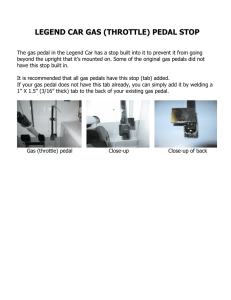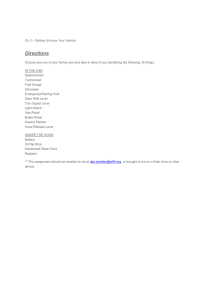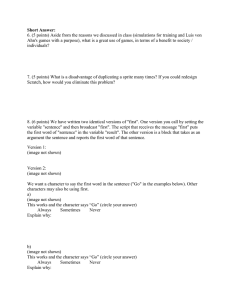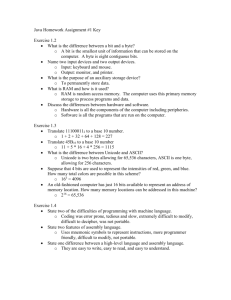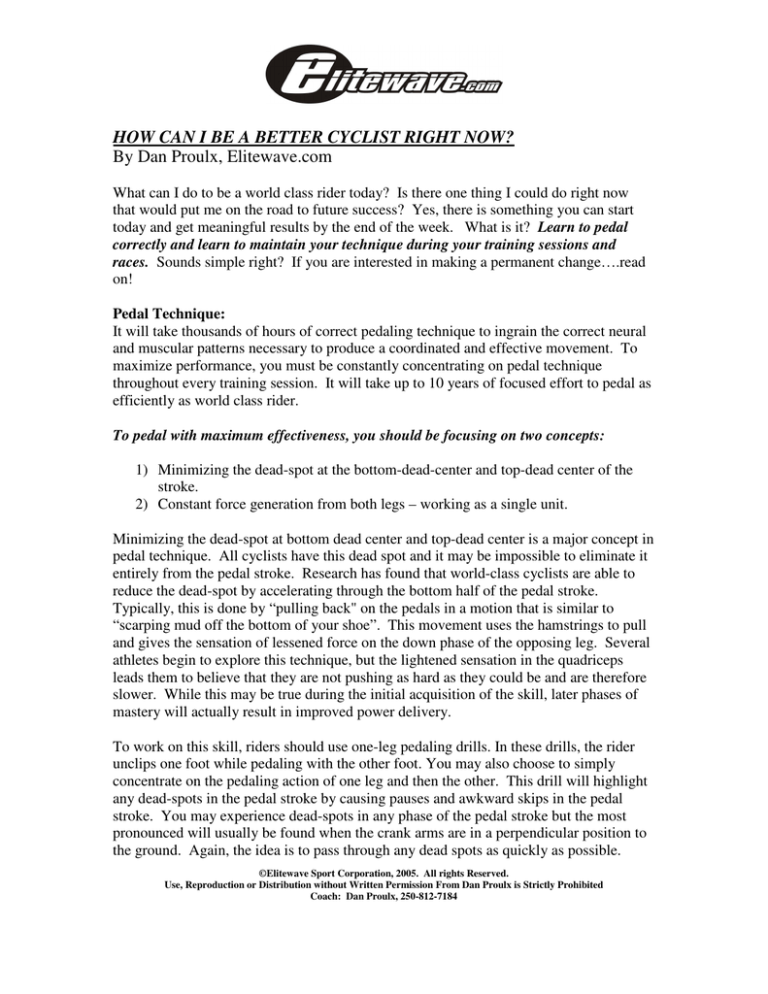
HOW CAN I BE A BETTER CYCLIST RIGHT NOW?
By Dan Proulx, Elitewave.com
What can I do to be a world class rider today? Is there one thing I could do right now
that would put me on the road to future success? Yes, there is something you can start
today and get meaningful results by the end of the week. What is it? Learn to pedal
correctly and learn to maintain your technique during your training sessions and
races. Sounds simple right? If you are interested in making a permanent change….read
on!
Pedal Technique:
It will take thousands of hours of correct pedaling technique to ingrain the correct neural
and muscular patterns necessary to produce a coordinated and effective movement. To
maximize performance, you must be constantly concentrating on pedal technique
throughout every training session. It will take up to 10 years of focused effort to pedal as
efficiently as world class rider.
To pedal with maximum effectiveness, you should be focusing on two concepts:
1) Minimizing the dead-spot at the bottom-dead-center and top-dead center of the
stroke.
2) Constant force generation from both legs – working as a single unit.
Minimizing the dead-spot at bottom dead center and top-dead center is a major concept in
pedal technique. All cyclists have this dead spot and it may be impossible to eliminate it
entirely from the pedal stroke. Research has found that world-class cyclists are able to
reduce the dead-spot by accelerating through the bottom half of the pedal stroke.
Typically, this is done by “pulling back" on the pedals in a motion that is similar to
“scarping mud off the bottom of your shoe”. This movement uses the hamstrings to pull
and gives the sensation of lessened force on the down phase of the opposing leg. Several
athletes begin to explore this technique, but the lightened sensation in the quadriceps
leads them to believe that they are not pushing as hard as they could be and are therefore
slower. While this may be true during the initial acquisition of the skill, later phases of
mastery will actually result in improved power delivery.
To work on this skill, riders should use one-leg pedaling drills. In these drills, the rider
unclips one foot while pedaling with the other foot. You may also choose to simply
concentrate on the pedaling action of one leg and then the other. This drill will highlight
any dead-spots in the pedal stroke by causing pauses and awkward skips in the pedal
stroke. You may experience dead-spots in any phase of the pedal stroke but the most
pronounced will usually be found when the crank arms are in a perpendicular position to
the ground. Again, the idea is to pass through any dead spots as quickly as possible.
©Elitewave Sport Corporation, 2005. All rights Reserved.
Use, Reproduction or Distribution without Written Permission From Dan Proulx is Strictly Prohibited
Coach: Dan Proulx, 250-812-7184
Cue Phrases for passing through the bottom dead center and top dead center phase of
the pedal stroke:
1) “Pull back”: Focusing on pulling with the hamstrings from 9 to 3 O’clock pedal
position
2) “Kick over”: Focusing on pushing forward from 3 O’clock and over the top to 9
O’clock position
Integration
It is important to transfer the skills and feedback from single leg pedaling to the full pedal
stroke. Riding with both feet clipped in, you will focus first on “pull back” for 5-10
seconds and then on “kick over” for 5-10 seconds. Next, you will combine these
movements into a full pedal stroke for 5-10 seconds. This takes a considerable amount of
energy, concentration and skill. The result will be increased speed and slightly increased
cadence.
In the initial phases of learning this technique, you may be deterred by the energy
expenditure that this attention to technique places on the muscles and mind. Athletes
usually do not get very far with this skill and often revert back to simply pushing down
on the pedals. If you are patient and perseverant, you can learn to pedal smoothly and
efficiently with this technique. At first, you will only be able to maintain it for very short
periods of time, but as you progress you will be able to hold it for longer and longer.
Remember, an elite athlete has usually repeated correct technique thousands and
thousands of time each year – often for 10 years or more. Every time you ride without
paying attention to correct pedal technique, you drift further and further away from
fulfilling your potential.
Bio-mechanists would be very upset with this overly simplified description of the
problem areas in pedal technique. They might point out that you are not actually pulling
back or kicking forward in the pedal stroke. Remember we are talking about cue words
and descriptions that are designed to coach correct form. These are descriptions used by
the coach in order to provide a memorable way of relating and creating improved
technique. I once had a National level coach, while I worked at the Olympic Oval
National Cycling Center, point out that these cues were not what was actually happening
in the pedal stroke. I agreed with him but pointed out that much of what actually happens
in a pedal stroke comes as a result of the bicycles construction (the way the cranks are
made). Of course you cannot actually push forward or pull back when the cranks will
always produce (no matter how bad you are) a round looking pedal stoke. The cues I was
shouting were for the athletes – not their bicycles! Statistical and scientific theory one
force application in pedal strokes are readily available to anyone who is
interested….coaches apply this knowledge in a unique way that athletes can understand
and use.
©Elitewave Sport Corporation, 2005. All rights Reserved.
Use, Reproduction or Distribution without Written Permission From Dan Proulx is Strictly Prohibited
Coach: Dan Proulx, 250-812-7184
Slow to Fast
Another simple way to learn proper pedal technique is to ride slowly in a moderate to
heavy gear on a flat road. The slower pedaling speed will allow you to feel each distinct
movement in the pedal stroke. As you become accustomed to these motions, lighten the
gear while continuing to emphasize technique. Continue moving to lighter gears until
you feel that you cannot maintain correct technique any longer at that cadence. Start the
drill over again in a moderate to hard gear and repeat. You should feel your skills
improving on each round. Remember, it will take years of this work to gain world-class
pedaling form.
How do my calf muscles contribute?
The calf muscles control the lever action of the foot. For the most part, the calf controls
the muscles of the lower leg and foot so that power can be transferred efficiently from the
quads, glutes and hamstrings and into the pedals. There is some "pawing" action under
heavy loads and low cadences (such as slow speed - steep climbs on the MTB) but
generally, the calf muscles are there only to assist in power transfer and the fluidity of
pedaling. Under extremely high cadences, such as in track sprinting (165+rpm) the calf
muscles are actually tightened so that there is almost no contribution from either the calve
or the foot in the pedal action. I suspect this is because added joint action in the ankle
and increased levering of the foot causes a slowing action in the pedal rotation. This
same control of joints is noted in track and field sprinters where sprints are done on the
toes with the calves contributing only to the push off at the start and then less and less as
the runner accelerates.
Other types of feedback for pedal technique:
1) Cycling computers and heart rate monitors
2) Rollers
3) Wattage
4) Power Cranks
5) Rotor Cranks
Cycling Computers and Heart Rate Monitors:
I was a guest speaker at the World Triathlon Coaches symposium in Edmonton during the
2001 World Triathlon Championships. I was speaking about the development of skills
and pedal technique with junior cyclists using rollers. I was fortunate enough to hear Dr.
Edmund Burke speak in one of the preceding lectures. Dr. Burke spoke about the
importance of correlating wattage, speed, cadence and heart rate to performance. Dr.
Burke had done analysis on Lance Armstrong’s pedaling technique (as it was just coming
into vogue) and asserted that Armstrong was pedaling at very high heart rates as a result
of his higher than average pedaling cadence. He noted that while higher heart rates might
lead many athletes to back-off, Armstrong maintained the cadence because the resulting
increase in wattage was at an acceptable cost in terms of heart rate and perceived
exertion. In simple terms, if his heart rate went up 10 beats but wattage jumped 30 watts
then it was worth the added cost of the effort. Dr. Burke reinforced the concept that
©Elitewave Sport Corporation, 2005. All rights Reserved.
Use, Reproduction or Distribution without Written Permission From Dan Proulx is Strictly Prohibited
Coach: Dan Proulx, 250-812-7184
wattage or speed must be understood in the context of energy cost to the athlete (heart
rate in this case). Sometimes it is acceptable to go over one’s red-line for an exponential
jump in speed or wattage.
If you are trying to figure out the correct pedaling technique, it can be as inexpensive and
easy as getting a cycling computer and a heart rate monitor. Start by riding a known loop
of 1-2km with your current pedaling technique. Take note of your average speed,
cadence (if possible) and heart rate. Now, apply the correct technique as described
above. You will notice that your cadence and speed increase. The question is – At what
cost? Pay careful attention to heart rate. If your heart rate jumps 5-10 beats – but speed
increases 2-3km/hr – this is probably an acceptable technical improvement. If however,
heart rate goes up 15 beats and speed only jumps 1 km/hr – then you are not being as
efficient as you can be. Through experimentation and experience, you can determine
what pedal technique increases the speed the most with the least effect on heart rate.
Your computer, based on consistent conditions, will tell you immediately if you are doing
correct pedal technique. Once you have done this for several sessions, you will begin to
associate certain physical sensations with correct technique. After a while, you will no
longer need the speedometer or heart rate monitor to tell you if you are riding correctly.
Rollers:
Rollers provide direct feedback to the athlete at all cadences. If you have lousy pedal
technique, you will soon find yourself face to face with the ground. In my opinion,
rollers are the best way to learn how to pedal properly. I would encourage all athletes to
be on the rollers at least once a week throughout the year. The rollers help you to isolate
and concentrate on your pedaling form. All of the drills mentioned above work even
better on rollers.
If you find yourself bouncing around on the rollers:
1) Make sure you are not riding in the drops. This changes the center of gravity and
weighting of the rear wheel on rollers.
2) Ride with technique described above. Bouncing often results from just pushing
down on the pedals.
3) The goal is to be able to ride smoothly, without bounce, at all cadences. You
should be comfortable and smooth at 140rpm minimum.
Wattage:
Wattage is the gold standard for measurement of technique through power output. If you
have access to a wattage device, it will really be beneficial to your riding. Is a wattage
system integral to meeting your potential? Definitely not. A reliable means of power
measurement (such as SRM) is a relatively recent occurrence for cycling athletes. There
have been 1000'
s of world class riders that were developed with nothing more than a bike
and a stop watch. Many of these riders performances would still be competitive today if
they were racing (i.e. Merckx and Boardman'
s Hour Records). The wattage testing
device is an incredible tool if you can afford it, but we must remember that it means
©Elitewave Sport Corporation, 2005. All rights Reserved.
Use, Reproduction or Distribution without Written Permission From Dan Proulx is Strictly Prohibited
Coach: Dan Proulx, 250-812-7184
nothing if you cannot train to your maximum potential or exceed your limits in a race.
An athlete'
s technique, will power and dedication still wins out over most technology.
That said, if you have the money, go and get the tools you need to be better!
Power Cranks:
Power Cranks offer a total immersion into the development of correct pedal technique.
The independent crank arms force the athlete to pedal with both legs in a coordinated
manner. This highlights one of the key aspects of pedal technique. You are not just
pushing with one leg and then the other! You are learning to use both legs and your body
together, as one unit, to create constant power generation. If you would like to really go
the distance in terms of learning how to pedal this way, the Power Cranks may be just
what you need to force yourself into being disciplined in this skill area. Power Cranks
advertises the advantage of their product by stating that "The strong leg cannot
compensate for the weak one."
Rotor Cranks:
Still think that this is too hard? You can actually buy crank arms that attempt to
eliminate the dead-spots entirely. By using a ratcheting arm, Rotor Cranks help the
athlete to accelerate through the dead-spots of the stroke. According to Rotor Cranks,
"Rotor Cranks work by increasing the force required on the drive side crankarm which
propels the non-drive crank past the 12 o'clock point ... also known as the dead spot.
This happens 180 times a minute in a 90RPM ride. Or 10,800 times an hour. The
cyclist is now "permanently pushing" the cranks as there is no gap between when the
legs take over push/recover duties, otherwise known as the dead spot. This elimination
of the dead spot allows the rider to produce more wattage and lower his/her lactate
threshold. The extra wattage is converted to speed in the amount of 2-3 minutes per
40k." Hmmmm…. not sure if we can believe all of that but think of the benefits you
could get just from learning to pedal with better technique on your own bike. Rotor
Crank has developed a piece of machinery worth a big chunk of change so that you don'
t
have to think or be as focused!
Fixed Gear:
I will be the first person to tell you that riding on the track will help you to be a smoother
and faster rider for any discipline. Would I advocate fixed gear training on the road as a
means to improve pedal technique? No! In my opinion, you can still have terrible
pedaling technique on a fixed gear bike. The construction of cranks does most of the
"making your pedal stroke round". You can still push down on each leg and not use your
hamstrings at all with a fixed gear. It'
s not that fixed gear bikes are inherently bad it'
s just
that you still have to be focused. It'
s possible to have good or bad pedal technique on a
free wheel or fixed gear system. If you want good technique, you have to be willing to
make a conscious choice. The bike won'
t do the job for you.
Efficient Cadence or Rhythm is another important factor in pedal technique. Notice that
I said Efficient and not Correct cadence. At the development level, it is simple to
©Elitewave Sport Corporation, 2005. All rights Reserved.
Use, Reproduction or Distribution without Written Permission From Dan Proulx is Strictly Prohibited
Coach: Dan Proulx, 250-812-7184
recommend specific cadences (correct cadences) for specific events and athletes. As the
cyclist becomes more developed, it is clear that different athletes move at different
cadences while achieving the same competitive speeds and times. Individuality of pedal
cadence is most important to timed events where fluctuations in speed are less frequent.
For events that involve regularly fluctuating speeds and efforts, it is important that
athletes adopt a cadence that favors higher RPM as this allows the athlete to be able to
respond to surges and attacks more rapidly. Additionally, the longer the event, the more
important higher cadence pedaling becomes. A light gear at high RPM will tax the
cardiovascular system more than the muscular system. Muscular fatigue is more difficult
to recover from than cardiovascular fatigue. New research even infers that “bonking”
may result more from muscular damage and fatigue than simply running low on fuel.
Long distance athletes – such as road racers – should adopt a cadence that focuses on
efficiency - a compromise between gear size and pedaling speed that allows the athlete to
minimize muscular damage and conserve energy while still permitting aggressive
responses to speed changes.
When you are racing or riding in a group it is important to remember how cadence will
impact the outcome of the performance. When a rider is in the pack, they should be in
the lightest gear possible that allows them to keep heart rate relatively low and still stay
in the draft. Often a fatigued rider will come off the front in a big gear and fail to shift to
easier gears as they drift back into the pack. This can be a costly mistake as opponents
may attack a rider who has just taken a pull. If that rider is still in a big gear it will make
the impact of this attack more dramatic. Remember, as you drift back into the slipstream,
you should also be switching into easier gears that allow your muscular system to recover
from the last effort. The easier gear will also allow you to jump when you need to.
Again, during the entire race it is important for the athlete to maintain efficient pedal
technique as described earlier.
The final component of pedal technique is Execution – being Relaxed enough to apply
correct pedal technique and cadence under extreme mental and physical situations. This
is one of the reasons why world class athletes look so smooth. They are able to deliver
on technique when it matters most. This is due in some part to the skill being second
nature – practiced thousands of times over years and years. It is also due to the winner'
s
mentality where every performance detail is scrutinized and developed. It'
s also the
result of these athletes taking ownership for creating Perfect Practices and driving
themselves to seek quality and concentration in every workout throughout their career.
When the average rider does workout after workout without paying attention to
detail…without taking technique seriously….without realizing that the little things
matter….they fall further and further behind the elite performers.
This article to be continued…….
Please email me any feedback or comments you may have. Dan@elitewave.com
©Elitewave Sport Corporation, 2005. All rights Reserved.
Use, Reproduction or Distribution without Written Permission From Dan Proulx is Strictly Prohibited
Coach: Dan Proulx, 250-812-7184


